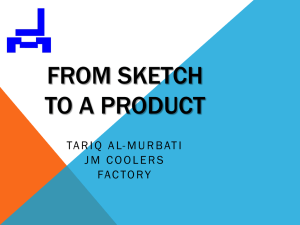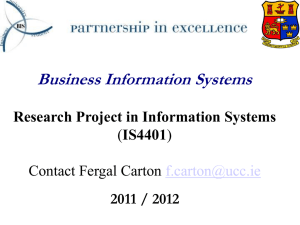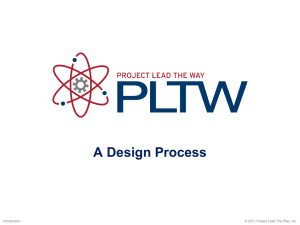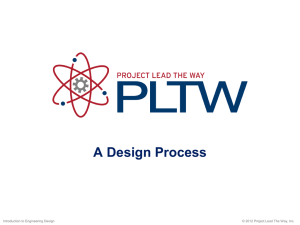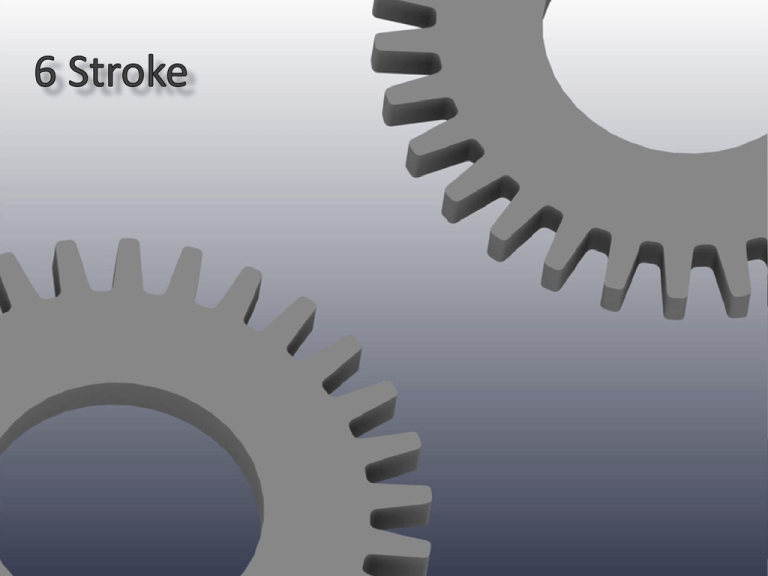
Team 6 Stroke
Tim Opperwall, John Mantel, Andrew DeJong, Marc Eberlein, Jim VanLeeuwen
Outline
• 6 Stroke Engine Theory
• Design Alternatives
1.
2.
Cam
Engine Control Unit (ECU)
•
Prototype Testing
•
Conclusions
•
Questions
4
6 Stroke Engine
1. Intake
2. Compression
3. Combustion
5. Water Injection
Theory
Design 1
Design 2
Prototype
4. Exhaust
6. Exhaust
Conclusion
Questions
1. Intake
Theory
Design 1
Design 2
Prototype
Conclusion
Questions
2. Compression
Theory
Design 1
Design 2
Prototype
Conclusion
Questions
3. Combustion
Theory
Design 1
Design 2
Prototype
Conclusion
Questions
4. Exhaust
Theory
Design 1
Design 2
Prototype
Conclusion
Questions
5. Water Injection
Theory
Design 1
Design 2
Prototype
Conclusion
Questions
6. Re-Exhaust
Theory
Design 1
Design 2
Prototype
Conclusion
Questions
Thermodynamics
Qin,gasoline
Wstroke-3
Qout,water
Qout,exhaust
Wstroke-5
Theory
Design 1
Design 2
Prototype
Conclusion
Questions
Precedence
• Patent for 6-Stroke I.C. Engine
– May 4, 1920 Leonard H Dyer
– Basic idea of using a water injecting fifth stroke to increase
efficiency and simplify the cooling of an internal combustion
engine.
• ‘Crower Engine’
– 2004 Bruce Crower
– Few calculations, but working prototype
• Senior Design
– 2009-10 Team 14
– Continued development
Theory
Design 1
Design 2
Prototype
Conclusion
Questions
Motivation
• Team interests
– Engines
– Energy efficiency
• Challenging project
• New ideas
Theory
Design 1
Design 2
Prototype
Conclusion
Questions
Design Goals and Norms
• Design a 6 Stroke Engine
• Manufacture a 6 Stroke Engine
• Transparency
• Stewardship
• Safety
Theory
Design 1
Design 2
Prototype
Conclusion
Questions
4 Stroke Engine Modeling
• Lotus Simulation
– Model single cylinder engine
– Fully customizable
– Helped approximate internal pressures
and temperatures
Theory
Design 1
Design 2
Prototype
Conclusion
Questions
6 Stroke Engine Modeling
• EES Calculations
– Determines combustion
composition
– Temperature, pressure,
enthalpy, and entropy at
each state point
h_air[3]=x_co2[3]*enthalpy(co2,t=T[3])+x_n2[3]*enthalpy(n2,t=T[3])
+x_o2[3]*enthalpy(o2,t=T[3])+x_h2o[3]*enthalpy(h2o,t=T[3])
Theory
Design 1
Design 2
Prototype
Conclusion
Questions
Design Alternatives
1. Camshaft Modification
• Mechanically controlled
• Extend crankcase to allow room
• Manufacture camshaft
2. Electrically Controlled Engine
• Program engine control unit (ECU)
• Remove cam controlled valves
• Replace with solenoid actuated valves
• Added capability between 4+6 strokes
• Head redesign
Theory
Design 1
Design 2
Prototype
Conclusion
Questions
Cam Design: Overview
Pushrods
Valves
Injector
Switch
Camshaft
Spark Plug
Flywheel
Theory
Design 1
Design 2
Prototype
Conclusion
Questions
Cam Design: Timing
Gear to
Reduction Shaft
Intake Cam
Exhaust Cam
Injector Cam
Exhaust Cam
Intake Cam
Measured 4-stroke Camshaft
Theory
Design 1
Design 2
The designed six stroke camshaft.
Prototype
Conclusion
Questions
ECU Design: Overview
Solenoids
Relays
ECU Brain
Injector
Thermocouple
Valves
Speed Sensors
Spark Plug
Flywheel
Theory
Design 1
Design 2
Prototype
Conclusion
Questions
ECU Design: Speed Sensors
The 1000 tooth encoder
used to communicate
engine speed to the ECU.
Theory
Design 1
Design 2
The optical sensor sends
high signal every top dead
center (TDC).
Prototype
Conclusion
Questions
ECU Design: Brain
Thermocouple
Speed Sensor
Input
Engine
Temperature
Engine Speed
and Position
Valve and
Injector Output
Theory
Design 1
Design 2
Prototype
Conclusion
Questions
ECU Design: Original Timing
The original valve lift profile.
Theory
Design 1
Design 2
Prototype
Conclusion
Questions
ECU Design: Brain Timing
Theory
Design 1
Design 2
Prototype
Conclusion
Questions
ECU Design: Relays
Theory
Design 1
Design 2
Prototype
Conclusion
Questions
ECU Design: Solenoids
• Few solenoids meet both force and speed requirements
Calculations for the required
force to open the exhaust.
Theory
Design 1
Design 2
Calculation for the
required stroke time.
Prototype
Conclusion
Questions
ECU Design: Solenoids
Valve Closing
Solenoid
Core
Valve Opening
Solenoid
Valve
Theory
Design 1
Design 2
Prototype
Conclusion
Questions
ECU Design: Solenoids
• Solenoid mounting system
• Laser-cut brackets
• Adjustability
– Threaded Rod
• Mounts to new head
Theory
Design 1
Design 2
Prototype
Conclusion
Questions
ECU Design: Spring
Theory
Design 1
Design 2
Prototype
Conclusion
Questions
ECU Design: Spring
Theory
Design 1
Design 2
Prototype
Conclusion
Questions
ECU Design: Water Injection
100psi air
injector
The GDI injector chosen to inject water during the fifth stroke.
Theory
Design 1
Design 2
Prototype
Conclusion
Questions
ECU Design: Head
Pushrod
Location
Valve Stem
Location
Spark Plug
Location
The original head for the engine.
Theory
Design 1
Design 2
Prototype
Conclusion
Questions
ECU Design: Head
• Head design and fabrication
– Drawn up in AutoCAD
– Manufactured by HighLight
Industries
– Houses original valves and
new water injector
Water Injector
Valve Location
Spark Plug
Theory
Design 1
Design 2
Prototype
Conclusion
Questions
Theory
Design 1
Design 2
Prototype
Conclusion
Questions
Conclusion: Goals
• Complete design for cam shaft alternative
• Complete design for ECU alternative
• Prototype sustained multiple combustions
– Single hardware limitation
Theory
Design 1
Design 2
Prototype
Conclusion
Questions
Conclusion: Obstacles
• Inadequate parts limit engine performance
• No EE’s on team
• Seeing the big picture
Theory
Design 1
Design 2
Prototype
Conclusion
Questions
Conclusion: Lessons
• Applied thermodynamics
• Prototyping
• Troubleshooting
• Team management
Theory
Design 1
Design 2
Prototype
Conclusion
Questions
Conclusion: Acknowledgements
• Professor Nielson – Team Advisor
• Ren Tubergen – Industrial Consultant
• Nick Hendriksma – Team Mentor
• Professor VanderLeest, Professor Brouwer, and Paul Bloem
– Electronic troubleshooting help
• Phil Jasperse – Machine shop
• Highlight Industries – Machine shop
Theory
Design 1
Design 2
Prototype
Conclusion
Questions


